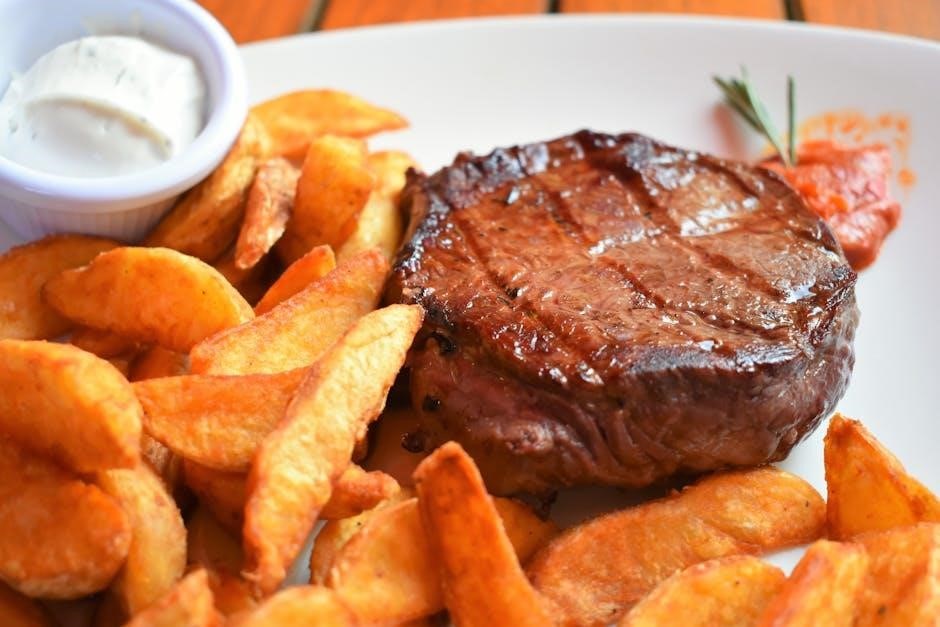This tailored meal plan combines a 1600-calorie intake with high protein content, designed to support weight loss while maintaining muscle mass and energy levels through nutrient-dense foods.
Overview of the Meal Plan
This 1600-calorie high-protein meal plan is designed to promote weight loss while maintaining muscle mass and energy levels. It focuses on nutrient-dense foods, ensuring a balance of macronutrients to keep you full and satisfied. The plan includes a variety of protein-rich foods such as chicken, fish, eggs, tofu, and legumes, along with healthy fats and fiber. Structured to provide approximately 77 grams of protein daily, it supports metabolic health and fat loss. Meals are distributed across breakfast, snacks, lunch, dinner, and even dessert, ensuring a balanced and sustainable approach to eating. Perfect for those seeking a structured yet flexible weight-loss plan.
Benefits of High Protein in Weight Loss
A high-protein diet is a powerful tool for weight loss, as it boosts metabolism, enhances satiety, and preserves muscle mass. Protein requires more energy to digest, increasing calorie burn and helping reduce fat storage. It also curbs cravings and keeps you fuller longer, making it easier to stick to a low-calorie plan. Additionally, protein supports lean muscle retention, which is crucial for maintaining a healthy metabolism during weight loss. Incorporating protein-rich foods like lean meats, fish, eggs, and legumes ensures you stay nourished while achieving your goals. Balancing protein intake with portion control is key to maximizing its benefits without excess calories or fat.

Understanding Caloric Needs for Weight Loss
Caloric needs vary based on age, sex, weight, and activity levels. A 1600-calorie diet is often recommended for weight loss, balancing energy needs with deficit creation.
How to Calculate Your Daily Calorie Requirements
To determine your daily calorie needs, consider factors like age, sex, weight, and activity level. Use an online calorie calculator or the Mifflin-St Jeor equation: BMR = 10w + 6.25h ‒ 5a + 5 for men, and BMR = 10w + 6.25h ‒ 5a ‒ 161 for women. Multiply your BMR by an activity factor: 1.2 for sedentary, 1.375 for moderately active, 1.55 for very active, and 1.9 for extra active. This gives your maintenance calories. For weight loss, create a deficit by reducing 500-750 calories daily. Adjust based on progress and consult a healthcare provider to ensure the plan suits your goals, especially for a 1600-calorie high-protein diet.
Importance of Protein in a Low-Calorie Diet
Protein is essential in a low-calorie diet as it helps preserve muscle mass during weight loss and boosts metabolism. High protein intake keeps you fuller longer, reducing cravings and overeating. It also supports fat burning and overall satiety, making it easier to stick to a calorie-restricted plan. Aim for lean sources like chicken, fish, eggs, and legumes to maximize benefits without excess calories. A protein-rich diet ensures sustained energy and maintains muscle tone, crucial for a successful and healthy weight loss journey within a 1600-calorie framework.
Structuring Your 1600 Calorie Meal Plan
Balance macronutrients with 1.6g of protein per kg of body weight, moderate carbs, and healthy fats. Focus on portion control, meal frequency, and hydration for optimal results.
Breakdown of Macronutrients for Optimal Weight Loss
A 1600-calorie high-protein meal plan typically allocates 40-50% of calories to protein, 30-40% to carbohydrates, and 20-30% to healthy fats. Protein supports muscle retention and satiety, with 1.6-2.2g per kg of body weight recommended daily. Complex carbs like whole grains, fruits, and vegetables provide sustained energy and fiber, while healthy fats from sources like avocados, nuts, and olive oil aid in hormone production and nutrient absorption. This balanced macronutrient distribution ensures metabolic efficiency, reduces hunger, and promotes fat loss while maintaining overall nutritional adequacy for sustainable weight management.
Meal Frequency and Portion Control
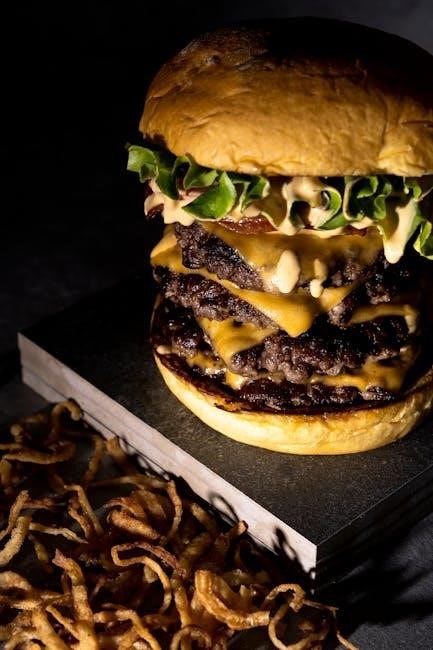
Eating 5-6 smaller meals throughout the day can help boost metabolism and control hunger, while maintaining the 1600-calorie limit. Portion control is essential to avoid exceeding daily calorie goals, even with protein-rich foods. Using smaller plates or measuring tools can help gauge appropriate serving sizes. Prioritizing whole, unprocessed foods like lean meats, fish, eggs, and legumes ensures satiety and nutrient density. Pairing protein with low-calorie vegetables or whole grains balances meals without overloading on calories. Consistency in meal timing and portion sizes helps maintain a steady energy supply and supports fat loss, making it easier to adhere to the high-protein, low-calorie plan long-term.

Sample 7-Day Meal Plan
This structured plan provides a daily breakdown of high-protein meals, ensuring a balance of nutrients while staying within the 1600-calorie limit, with options like eggs, chicken, and fish.
Day 1: High-Protein Breakfast to Dinner
Breakfast: Start with scrambled eggs (3 whole, 1 yolk) and a slice of whole-grain toast for 220 calories and 18g of protein. Add a side of spinach for extra nutrients.
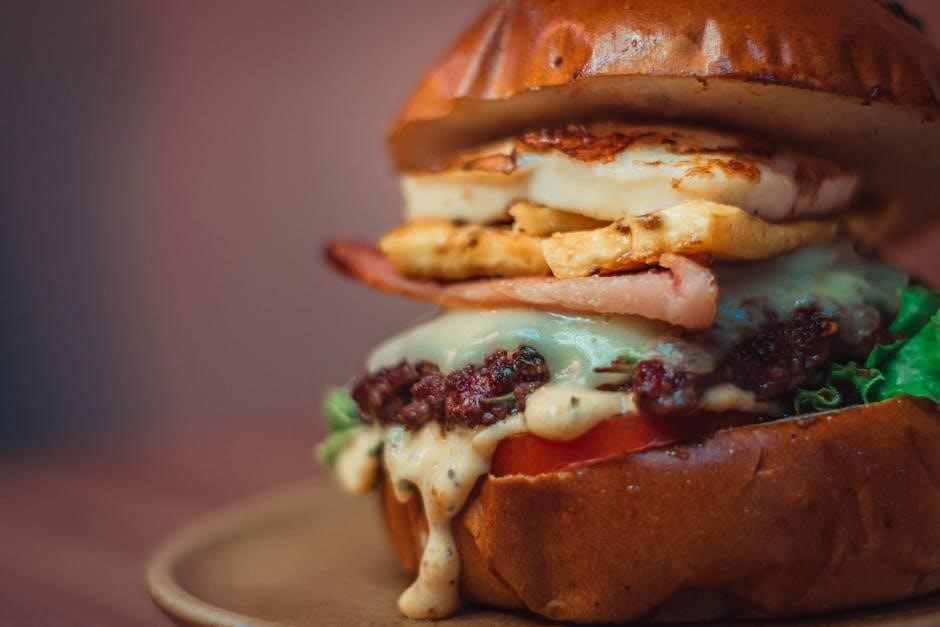
Lunch: Grilled chicken breast (4 oz) with quinoa and steamed broccoli, totaling 320 calories and 35g of protein, ensuring satiety and muscle support.
Dinner: Baked salmon (5 oz) with brown rice and asparagus, providing 300 calories and 30g of protein, rich in omega-3 fatty acids for overall health.
Snack: A small Greek yogurt with berries adds 100 calories and 10g of protein, keeping metabolism active throughout the day.
Total: 940 calories and 93g of protein, aligning with the 1600-calorie goal while maximizing protein intake for weight loss and muscle retention.
Day 2: Balanced Meals with Protein-Rich Snacks
Breakfast: Turkey and avocado wrap with a whole-grain tortilla, lettuce, and tomato, totaling 250 calories and 25g of protein for a satisfying start.
Lunch: Grilled chicken Caesar salad with romaine lettuce, 1 tbsp Caesar dressing, and 1 slice of whole-grain croutons, providing 280 calories and 30g of protein.
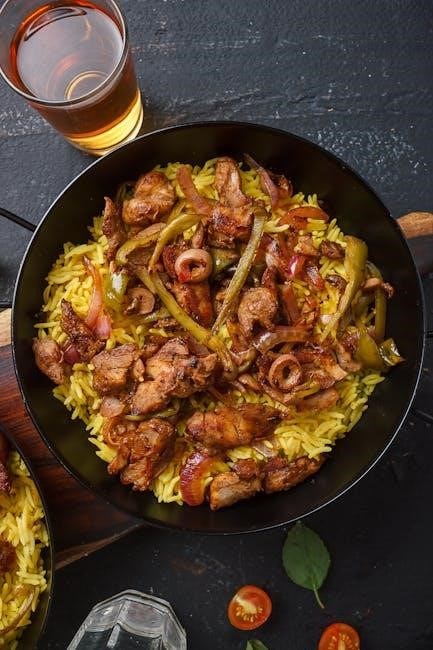
Dinner: Shrimp stir-fry with mixed vegetables (bell peppers, carrots) and brown rice, offering 290 calories and 20g of protein, packed with fiber and vitamins.
Snacks: A hard-boiled egg (78 calories, 6g protein) and a handful of almonds (100 calories, 4g protein) keep energy levels steady between meals.
This balanced approach ensures a variety of flavors and nutrients while maintaining the 1600-calorie goal and high protein intake for optimal weight loss.
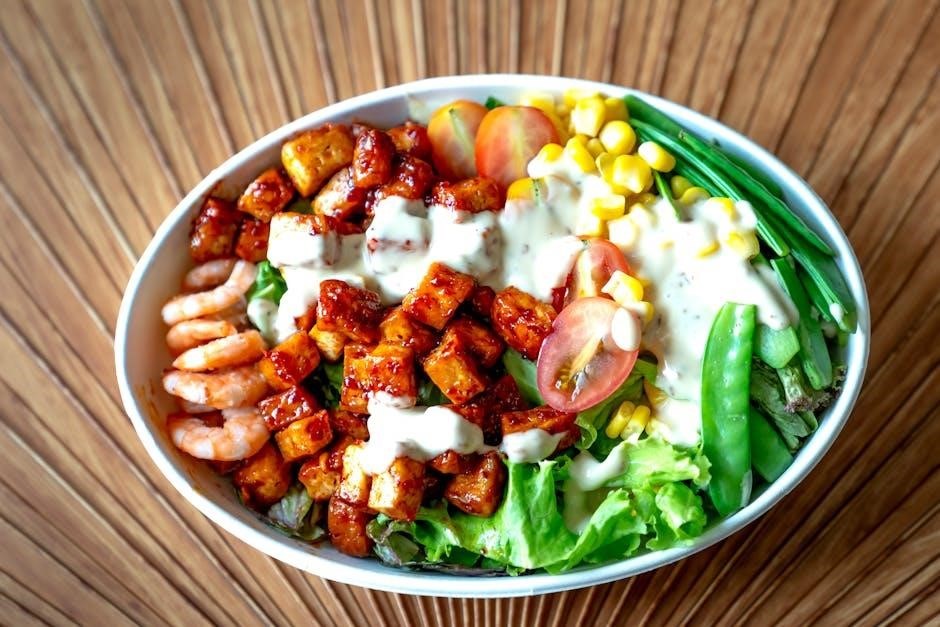
Snacking Strategies for Protein Intake
Incorporate protein-rich snacks like hard-boiled eggs or almonds to maintain muscle mass and metabolism, ensuring each snack stays under 100 calories while boosting protein intake effectively.
Healthy Snack Options Under 100 Calories
For a high-protein, low-calorie diet, opt for snacks like hard-boiled eggs (78 calories, 6g protein), almonds (1 oz, 161 calories, 6g protein), or Greek yogurt (100 calories, 10g protein).
Edamame (½ cup, 100 calories, 10g protein) and cottage cheese (½ cup, 80 calories, 11g protein) are also excellent choices.
Additionally, protein smoothies (whey protein with water) or turkey slices (2 oz, 70 calories, 15g protein) can satisfy cravings without exceeding calorie limits.
These snacks provide essential nutrients, keep you full, and support muscle maintenance without derailing your calorie goals.
Timing Your Snacks for Maximum Metabolism Boost
Timing your snacks strategically can enhance metabolism and support weight loss. Aim to eat protein-rich snacks in the morning to kickstart your metabolism after an overnight fast.
Include a snack 30 minutes before workouts to fuel energy and promote muscle preservation.
Opt for a post-workout snack within 30-60 minutes to aid recovery and maintain metabolic rate.
Avoid late-night snacking as it can hinder weight loss efforts. Instead, space out snacks evenly throughout the day to keep metabolism active and prevent hunger-induced overeating.
Proper timing ensures your body utilizes nutrients efficiently, maximizing the benefits of your high-protein, low-calorie diet.
Nutritional Balance in the Meal Plan

This meal plan emphasizes balanced nutrition, combining high-quality proteins, healthy fats, and complex carbohydrates to ensure sustained energy, optimal health, and effective weight management within the 1600-calorie framework.
Incorporating Fiber and Healthy Fats
Fiber and healthy fats are essential for a balanced diet, aiding digestion and satiety. Whole grains, legumes, and vegetables provide fiber, while avocados, nuts, and olive oil offer healthy fats. These components support heart health and energy levels, ensuring meals are satisfying and nutritionally complete within the 1600-calorie plan. By including these elements, the meal plan promotes overall well-being and sustainable weight management, complementing high protein intake for a holistic approach to nutrition.
Hydration and Its Role in Weight Loss
Hydration plays a crucial role in weight loss by boosting metabolism and suppressing appetite. Drinking enough water helps maintain digestion and prevents overeating. Even mild dehydration can slow metabolic rates and reduce energy levels, hindering weight loss efforts. Incorporating water-rich foods like cucumbers and oranges can also contribute to hydration. Staying hydrated supports the body’s ability to efficiently burn calories and process nutrients, making it an essential component of a successful 1600-calorie high-protein meal plan. Prioritizing water intake ensures optimal physiological function, aiding in achieving and maintaining weight loss goals effectively.
Sustaining the Meal Plan Long-Term
Sustaining a 1600-calorie high-protein meal plan requires consistent meal prepping, smart grocery shopping, and maintaining motivation to ensure long-term success and overall health.
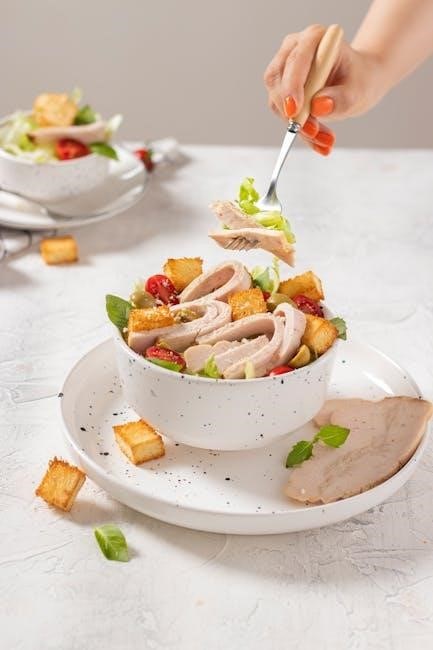
Grocery Shopping Tips for High-Protein Diets
When shopping for a high-protein diet, prioritize lean meats like chicken, turkey, and fish. Incorporate plant-based proteins such as beans, lentils, and tofu. Opt for whole, unprocessed foods to avoid hidden calories and sugars. Plan meals in advance to avoid impulse buys and ensure you have protein-rich staples like eggs, Greek yogurt, and edamame. Consider budget-friendly options such as canned tuna or chickpeas. Always check nutrition labels to ensure products align with your calorie and protein goals. Stock up on spices and seasonings to keep meals flavorful without adding extra calories. A well-organized grocery list helps maintain consistency and supports long-term success.
Maintaining Motivation and Consistency
Staying motivated on a 1600-calorie high-protein meal plan requires setting realistic goals and tracking progress. Celebrate small milestones, like weekly weight loss or increased energy levels, to stay encouraged. Share your journey with a support system, such as friends or online communities, to gain accountability. Avoid strict restrictions by allowing occasional treats, ensuring the plan feels sustainable. Focus on how high-protein meals make you feel—more satisfied and energetic—to reinforce commitment. Remind yourself of the long-term benefits, like improved health and confidence, to maintain consistency. Over time, these habits will become a natural part of your lifestyle, making it easier to stick to the plan.
